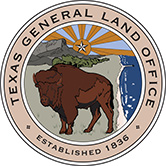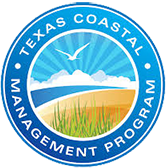Glossary
Accretion
The gradual addition of new material by deposition of sediment carried by wind and waves.
Algal mats
Layer of algae typically found on a tidal flat
Back-island sand dunes
Dunes located on the landward side of barrier island, usually adjacent to the bay margin.
Backshore or backbeach
The upper zone of the shore or beach, lying between the high-water line of mean spring tides and the upper limit of shore-zone processes (edge of dunes, cliff, etc.): it is acted upon by waves or covered by water during exceptionally severe storms or unusually high tides. It is separated from foreshore by the crest of the most seaward berm.
Barrier island
A long, narrow coastal island separated from the mainland by a lagoon or estuary. It commonly has dunes, vegetated zones, and marshy terranes extending lagoonward from the beach.
Bay margin
Area adjacent to the bay or other body of estuarine waters that is influenced by tidal waters
Beach
The gently sloping shore of a body of water which is washed by waves or tides.
Berm
A low shelf or narrow terrace on the backshore of a beach formed of material deposited by storm waves.
Berm crest
The seaward limit and generally the highest point of a berm on a beach. The crest of the most seaward berm separates the foreshore from the backshore.
Breaker
A wave that has become so steep that the crest outpaces the body of the wave and collapses into a turbulent mass on shore.
Coppice dune
Small dunes formed by the accumulation of wind blown sand on the backshore just seaward of the foredunes and anchored by vegetation. With an adequate sediment supply these mounds could grow larger, become continuous, and form a new foredune system.
Crest (dune or wave)
The highest point on a dune, the highest part of a wave.
Diurnal tide
One high and one low tide every 24.8 hours
Erosion
The wearing away of sand by the action of waves and wind.
Estuarine
Of, pertaining to, or formed in an estuary.
Estuary
A partially enclosed coastal body of water where the tide meets the current of a stream.
Fetch
The extent of open water wind travels across.
Foredune
A coastal dune at the landward margin of a beach, more or less completely stabilized by vegetation.
Foredune crest
Highest part of foredune.
Fore-island dunes
System of coastal dunes separating the beach from the vegetated barrier flat.
Foreshore or forebeach
The zone of the shore or beach that is regularly covered and uncovered by the rise and fall of the tide.
High tide
The tide at its highest: the maximum level reached during a tidal cycle.
Hurricane
A tropical cyclone in which the maximum sustained surface wind is 64 kt (74 mph or 119 km/hr) or more.
Longshore current
Ocean current caused by the approach of waves to a coast at an angle. It flows parallel to and near to the shore.
Longshore drift
Transport of material (sand, shell fragments, etc.) along the coast by longshore currents.
Longshore bar
A low sand ridge built mainly by wave action, occurring at some distance from and parallel with the shoreline.
Marine grassflat
Area of seagrass growth in marine waters.
Neap tide
A tide occurring at the first and third quarters of the moon, when the gravitational pull of the sun opposes that of the moon, and having an unusually small or reduced tide range.
Salt marsh
A saturated, poorly drained area, intermittently or permanently flooded with salt water, having aquatic and grasslike vegetation.
Scarp
An almost vertical slope fronting a berm on a beach or dune caused by wave erosion. It may range in height from several centimeters to a few meters, depending on the character of the wave action and the nature and composition of the beach.
Semidiurnal tide
A tide with two high and two low waters every 24.8 hours.
Spring tide
A tide occurring twice each month, at or near the times of new moon and full moon, when the gravitational pull of the sun reinforces that of the moon. It has an unusually large or increased tide range.
Storm surge
An abnormal, sudden rise of sea level along an open coast during a storm, caused primarily by onshore winds, resulting in water piled up against the coast. It is most severe when accompanied by a high tide.
Surf zone
The area bounded by the landward limit of wave uprush and the farthest seaward breaker.
Swash zone
The zone over which water rushes up onto the beach following the breaking of a wave.
Tidal flat
An extensive, nearly horizontal barren tract of land that is alternately covered and uncovered by the tide, and consisting of unconsolidated sediment.
Tidal inlet
Any inlet through which water flows alternately landward with the rising tide and seaward with the falling tide: specifically a natural inlet maintained by tidal currents.
Tidal range
The difference between the level of water at high and low tide.
Tide
The rhythmic, alternate rise and fall of the surface of the ocean resulting from the gravitational attraction of the moon (and, of a lesser degree, of the sun) acting unequally on different parts of the rotating earth. Gravity waves.
Tropical cyclone
A warm-core non-frontal synoptic-scale cyclone, originating over tropical or subtropical waters, with organized deep convection and a closed surface wind circulation about a well-defined center. Once formed, a tropical cyclone is maintained by the extraction of heat energy from the ocean at high temperature and heat export at the low temperatures of the upper troposphere.
Tropical depression
A tropical cyclone in which the maximum sustained surface wind speed is 33 kt (38 mph or 62 km/hr) or less.
Tropical storm
A tropical cyclone in which the maximum sustained surface wind speed ranges from 34 kt (39 mph or 63 km/hr) to 63 kt (73 mph or 118 km/hr). Once a tropical cyclone is upgraded to a tropical storm it is given a name.
Trough (dune or wave)
The lowest point on a dune, the lowest part of a wave.
Vegetated barrier flat
A flat, low-relief but bumpy plain that extends from landward of the fore-island dune system to the bay margin on a barrier island, vegetated with grasses and other low vegetation. May have patches of back-island dunes as well as depressions that may host small freshwater ponds and marshes.
Vegetation line
Seaward extent of vegetation, usually seaward of the foredunes. Some beaches have many vegetation lines (i.e. one line marking extent of continuous landward vegetation, another marking boundary of a sparsely vegetated area).
Washover
Small deltas built on the landward side of a barrier island produced by storm waves breaking over low places and depositing sediment on the back side of the island or in the water body behind the island. It is also the process by which a washover feature is formed.
Washover channel
Channel through which tidal waters can alternately flow landward and seaward on a washover.
Wave
An oscillatory movement in a body of water manifested by an alternate rise and fall of the surface.
Wave height
The vertical distance between a wave’s crest and trough.
Wavelength
The distance between successive wave crests, or other equivalent points.
Wave period
The time it takes successive wave crests to pass a fixed point.
Wet/dry line
The line between wet sand and dry sand on the forebeach. Marks highest level of wave swash and is typically associated with the berm crest.
Wrack line
a line of debris left on the backshore following an extremely high water level.



.png)